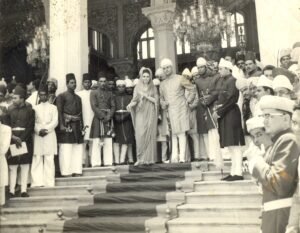National income is the value of goods and services produced by the citizens of a country. The first national income in India was estimated by Dadabhai Naoroji in 1867-68 and the total national income of the country was Rs.320 crore and per capita income was Rs.20. (annual). But in this method of calculation of National income, the production of non-agricultural sector was added to the value of agricultural commodities, but in 1931 . By using production and income method by V. Rao, the national income was estimated and the national income was Rs.78. Per capita income stated. In his method, he added the net income received from abroad to the total income received from forest, agriculture, mining. Dr. Rao’s assessment was considered the first scientific assessment.
On August 19.49, the National Income Committee was constituted under the chairmanship of Prof. P.C. Mahala Nobis, its other members Prof. Dr. Godgil and Dr. V.K.R. & RP Rao. This committee submitted its report in 1951 and on its recommendations, 250 (Central Allied Commission) was constituted in 1951.
Key Concepts for Estimation of National Income
The main concepts used to measure national income are as follows:
GDP (Gross Domestic Product)
Gross Domestic Product refers to the value of goods and services produced in a country in a financial year. To calculate GDP, the economy is divided into 3 sectors.
Primary sector
Primary sector refers to those natural resources which are used directly after exploitation. It covers 5 major areas-
- Agriculture
- Mining
- Forest
- Fishing
- Animal Husbandry
Secondary sector
Secondary sector refers to industry and manufacturing, industrial development is considered to be the basis in any economy and only through industrial development can employment generation, poverty alleviation and surplus production be done. Even in the present time, some countries (G7) countries have attained (G7) developed nation status only through industrial development.
Tertiary sector
This sector refers to the services available to individuals which include hotels, trade: transport, telecommunications etc. Presently India has come a long way in this field.
The contribution of primary sectors in the country’s economy is high means that secondary and tertiary sector has not developed in that country and it shows industrial and technological backwardness. Initially, the contribution of the primary sector to the GDP in the Indian economy was about 53%.
The GDP takes the acquisition of recently delivered labour and products for a specific period into account. In computing the GDP, the emphasis is on the complete worth of labour and products created inside the nation borders, regardless of whether the worth expansion is because of the occupants or non-inhabitants of the country.
There are two techniques for computing GDP. They are:
- Expenditure methodology
- Income methodology
The use approach considers including all the sum spent on labour and products during the period.
Where,
C = Consumption spending
I = Business investments (Capital equipment’s, inventories)
G = Government purchases
X = Exports
M = Imports
Income approach: Under the income approach, the GDP is calculated by adding up three factors.
Net domestic product (NDP)
Net homegrown item (NDP) is a yearly proportion of the monetary result of a country that is determined by deducting devaluation from total national output (GDP).
Net homegrown item (NDP) is a yearly proportion of the monetary result of a country that is changed in accordance with represent deterioration.
It is determined by deducting devaluation from the total national output (GDP).
NDP, alongside GDP, gross public pay (GNI), discretionary cashflow, and individual pay, is one of the vital checks of monetary development that is accounted for on a quarterly premise by the Bureau of Economic Analysis (BEA).
An expansion in NDP would demonstrate developing financial wellbeing, while a diminishing would show monetary stagnation.
Gross worth added (GVA)
Gross worth added (GVA) is the proportion of the absolute worth of labor and products delivered in an economy( region, locale or country). How much worth added to an item is considered.
GVA can be characterized as result created in the wake of deducting the middle of the road worth of utilization. This can likewise be referenced as :
- The base year for the computation of GVA has additionally been moved to 2011-2012 from the prior 2004-2005.
- Prior, India had been estimating GVA at ‘factor cost’ till the new approach was embraced in which GVA at ‘essential costs’ turned into the essential proportion of financial result.
- GVA at fundamental costs will incorporate creation burdens and prohibit creation endowments.
- GVA at factor cost incorporated no assessments and rejected no sponsorships.
The NSO gives both quarterly and yearly gauges of the result of GVA. It gives sectoral grouping information on eight general classifications that incorporate the two products delivered and benefits gave in the economy.
- Mining and Quarrying.
- Producing.
- Horticulture, Forestry and Fishing.
- Power, Gas, Water Supply and other Utility Services.
- Monetary, Real Estate and Professional Services.
- Policy management, Defense and different Services.
- Development.
- Exchange, Hotels, Transport, Communication and Services connected with Broadcasting.
Gross National Product
GNP is known as gross public item and addresses the complete worth of labor and products created by the inhabitants of a country during a monetary year.
It takes the pay procured by the residents of the nation present inside or outside the country into thought. It rejects the pay produced by the outside nationals who are living in the country. It very well may be determined as:
Where,
GDP = Gross domestic product
NR = Net income receipts
NP = Net outflow to foreign assets
Difference between GDP & GNP
| GDP | GNP |
| Gross Domestic Product | Gross National Product |
| An assessed worth of the all out worth of a nation’s creation and administrations, inside its limit, by its nationals and outsiders, determined over the seminar on one year. | An assessed worth of the all out worth of creation and administrations, by residents of a nation, on its territory or on unfamiliar land, determined over the seminar on one year. |
| GDP = utilization + speculation + (government spending) + (trades − imports). | GNP = GDP + NR (Net pay inflow from resources abroad or Net Income Receipts) – NP (Net installment surge to unfamiliar resources). |
| Total worth of items and Services created inside the regional limit of a country. | Total worth of Goods and Services delivered by all nationals of a country (whether inside or outside the country). |
| To see the strength of a country’s neighborhood economy. | To perceive how the nationals of a nation are doing financially. |
Net National Product (NNP)
Elements of creation under go mileage. This mileage is called Depreciation. A piece of capital is utilized for this mileage which isn’t utilized underway of labor and products.
Assuming we deduct deterioration from the GNP, we get is NNP
Net National Product (@Market Price) = Gross National Product – Depreciation
Presently
In any case, the Central Statistics Office (CSO) under the Ministry of Statistics and Program Implementation characterizes National Income of India as Net National Income at Market Price
Individual Income (PI)
Individual Income is the piece of National Income which is gotten by the families.
The equation for computing Personal Income (PI) is-
installments made by families – Corporate expense + Transfer installments to
the families from the public authority and firms.
- Undistributed benefits – these are the benefits which isn’t conveyed to the families
- Corporate Tax – It additionally doesn’t gather to the families
Personal Disposable Income
Individual Disposable Income alludes to the pay that is accessible to the families that they can spent as they wish.
All the Personal Income isn’t accessible to people to spend. They need to make good on charges (eg – Income charge) and non charge installment like fines.
The recipe for Personal Disposable Income is
Hence, Personal Disposable Income is the piece of total pay which have a place with the families. They might choose to consume a piece of it, and save the rest.
National Disposable Income
Public Disposable Income provides us with a thought of what is the greatest measure of labor and products the homegrown economy has available to its
The recipe for National Disposable Income is
Current exchanges from the remainder of the world incorporates things, for example, gifts, helps and so on
Private Income
The recipe for Private Income is
Confidential Income = Factor pay from net homegrown item gathering to the confidential area + National obligation interest + Net variable pay from abroad + Current exchanges from government + Other net exchanges from the remainder of the world
Gross versus Net worth added
Creation factors, for example, machines, hardware, devices, manufacturing plant structures, farm haulers and so on deteriorate throughout some undefined time frame during the course of creation. Reality may eventually show that after specific time these capital products needs substitution.
The capital utilized for the this mileage and isn’t important for any body’s pay.
In this way we deduct deterioration from the GDP to get Net GDP
Net GDP = GDP – Depreciation
Additionally, Net National Product (NNP) = GNP – deterioration
| Method Of calculate nation Income |
1.Production Calculation Method
When the goods and services produced from different sectors of the economy are added up in a financial year, it is called production based national income. market value of
2. Consumption or Expenditure Method
While working out the national income by this method, a savings and investment are added by the total expenditure to be made in the financial year by the government.
3. Income Calculation Method
In this method, the amount of money paid for the services rendered in a year by the means of production in different sectors of the economy is added up. In this method wages, salaries, profits of companies, etc. are added. (Subsidy is deducted.)
Factors hindering the calculation of national income
- non-monetary transactions.
- Some services like housewives not getting money for their service
- domestic production by foreign companies
- Non-fixation of price of goods for own use.
- Lack of accurate and sufficient data.
- Lack of public participation.
- Problem in determining the final item.
The government should give a high priority to implementing measures to bolster manufacturing output and kick-start an upturn in the investment cycle.
Accelerated spending by the government is another way out but this action would be opposite to the government’s fiscal deficit target of 3.3% of GDP.
Frequently Asked Question
Q1. Does GNP incorporate devaluation?
Ans.GNP additionally incorporates duties and devaluation. The expense of administrations utilized in creating merchandise isn’t processed autonomously since it is remembered for the expense of completed items. For year-to-year examinations, Gross National Product should be adapted to expansion to deliver genuine GNP.
Q2. Why NDP isn’t utilized in relative financial aspects?
Ans.NDP isn’t utilized for the near economies since the pace of deterioration is different for various nations. In India NDP is reported by the Ministry of Commerce and Industry
Q3. Why GDP is generally utilized than NDP?
Ans.Likewise, a developing hole among GDP and NDP shows expanding outdated nature of capital products, while a restricting hole implies that the state of capital stock in the nation is getting to the next level. It decreases the worth of capital for that reason it is isolated from GDP to get NDP.
Q4. Are charges remembered for NNP?
Ans.In public pay bookkeeping, net public pay (NNI) is net public item (NNP) less aberrant charges. Net public pay includes the pay of families, organizations, and the public authority.
Q5. What variables impact GDP?
Ans.The four inventory factors are normal assets, capital products, HR and innovation and they straightforwardly affect the worth of good and administrations provided. Financial development estimated by GDP implies the increment of the development pace of GDP, however what decides the increment of every part is totally different.



